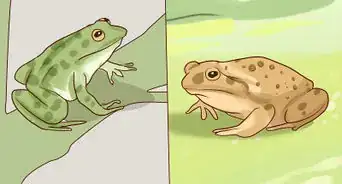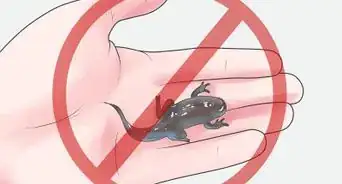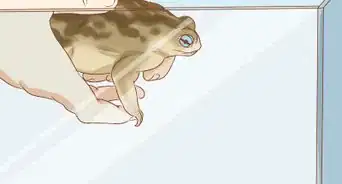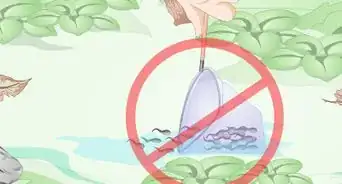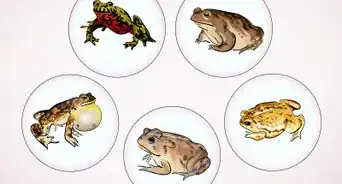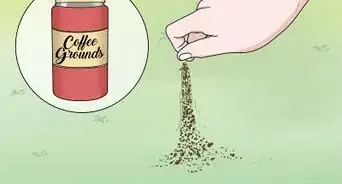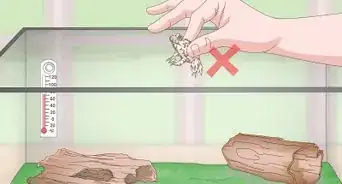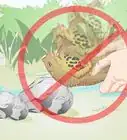This article was co-authored by wikiHow Staff. Our trained team of editors and researchers validate articles for accuracy and comprehensiveness. wikiHow's Content Management Team carefully monitors the work from our editorial staff to ensure that each article is backed by trusted research and meets our high quality standards.
This article has been viewed 70,850 times.
Learn more...
American toads are great pets for people who are interested in amphibians but want a pet that’s easy to take care of. To keep your pet toad happy, make sure its terrarium has all of the necessities, like water and substrate, as well as a few extra items, like plants and rocks. Toads are carnivores, so they will need plenty of spaces to hunt and eat crickets and other insects in their tank!
Steps
Setting Up the Tank
-
1Choose a tank that is at least 10 US gal (38 L) for your toad. Toads need plenty of space to hide, burrow, and jump around. Upgrade by an extra 10 gallons (38 L) for each additional toad to ensure that they have enough space to move about in the tank. Always position the tank out of direct sunlight to avoid making the environment too warm.[1]
- You can find suitable tanks of various sizes at most pet stores. Most of them are made of glass or plastic.
-
2Add a coconut fiber substrate that is at least 4 in (10 cm) deep. Pour the substrate into the tank and level it out so the toad can find places to burrow. As the toad feels more comfortable, it will begin to dig and move the substrate around, which is normal.[2]
- If you can’t find coconut fiber substrate at the pet store, opt for peat moss.
Warning: Avoid substrate made out of sand or other fine particles, as they can be harmful to your toad if eaten.
Advertisement -
3Fill a sturdy, shallow bowl with water and bury it in the substrate. Choose a solid ceramic bowl that’s deep enough to fit your toad inside. Then, add enough dechlorinated water for the toad to completely submerge itself and stay hydrated. Dig a hole in the substrate and situate the bowl in the tank, pushing the substrate up to the sides of the bowl.
- If you don’t have a water filter to remove chlorine, add dechlorinated drops to the water before you put it in the tank. Chlorine is very dangerous for toads, and you can purchase the drops at most pet stores.
- Be sure to change the water every 2 days so that it’s fresh for your pet.
-
4Install a thermometer and a hygrometer on the tank. Toads prefer cooler temperatures with high humidity. Place the meters on one side of the tank, and check them daily. The temperature should be around 60–75 °F (16–24 °C), and the humidity should stay around 50%. If the tank is too hot, add cooler water to the bowl and make sure there is plenty of substrate so the toad can burrow to stay cool.
- Since toads prefer cooler weather, they don’t normally require a UV light to keep them warm.
- If the humidity drops below 50%, mist the tank with clean water 2-3 times per day until it returns to normal.
-
5Secure a tight-fitting, screen lid on the top of the enclosure for safety. Toads can jump pretty high, and they can easily knock the lid off of your tank. Make sure the lid has holes for ventilation and doesn’t easily move when pressed. If the screen is loose, the toad could escape from the tank.[3]
- Always remember to secure the lid when you’re done working in the tank.
Adding Accessories
-
1Add leaf litter or cork bark on top of the substrate so your toad can hide. A normal coconut substrate can be comfortable for burrowing, but toads also like to camouflage themselves under larger items. Sprinkle a layer of bark or leaves around the tank to create a variety of places where your toad can conceal itself.[4]
- You can find cork bark or leaf litter at most pet stores or outdoor landscape centers.
-
2Place a few living or plastic plants throughout the enclosure for more coverage. If you want the tank to seem more like the toad’s natural habitat, pick up 3-4 small plants, either real or fake. Position them around the tank to give the toad a few places where it can hide when it’s not burrowing or wading.[5]
- If you're going to use real plants, opt for a few Golden Pothos, Epiphyte, or Calathea, since they're easy to maintain and safe for the toad.
Tip: Keep in mind that your toad might disrupt the roots of a real plant, so it may be best to stick with fake plants.
-
3Position small clay pots and rocks throughout the terrarium to hold humidity. If you want a few more places for your toad to hide that will also keep the terrarium humid, lay a small clay pot on its side in the tank, and add 2-3 rocks on the top of the substrate. When you mist the tank, be sure to spray the pot and rocks, since they hold moisture and release it slowly.[6]
- Be sure to keep the clay pots tipped on their sides, since the toads might jump into them and get stuck if they’re placed upright.
Community Q&A
-
QuestionCan I keep a gray tree frog with an American toad?
 XxmoonhunterCommunity AnswerThey may brutally murder each other. It's a risk.
XxmoonhunterCommunity AnswerThey may brutally murder each other. It's a risk. -
QuestionI don't have a lot of bugs near my house, so can toads eat fruit?
 MarlsbadCommunity AnswerThey should not be eating fruit, as they are carnivorous. Crickets are a good food choice, and can be purchased at any local pet store. You can also purchase other critters like earthworms and fruit flies, often available at pet stores as well.
MarlsbadCommunity AnswerThey should not be eating fruit, as they are carnivorous. Crickets are a good food choice, and can be purchased at any local pet store. You can also purchase other critters like earthworms and fruit flies, often available at pet stores as well. -
QuestionWill they eat fruits and vegetables?
 Community AnswerNo, they are insectivores, and feed on live insects.
Community AnswerNo, they are insectivores, and feed on live insects.
Things You'll Need
- Tank with screen lid
- Substrate
- Water dish
- Dechlorinated water
- Thermometer
- Hygrometer
- Artificial or real plants
References
- ↑ http://www.frogpets.com/american-toad/
- ↑ http://www.frogpets.com/american-toad/
- ↑ http://www.reptilesmagazine.com/Frogs-Amphibians/American-Toad-Feeding-And-Care/
- ↑ http://www.reptilesmagazine.com/Frogs-Amphibians/American-Toad-Feeding-And-Care/
- ↑ http://www.frogpets.com/american-toad/
- ↑ http://www.reptilesmagazine.com/Frogs-Amphibians/American-Toad-Feeding-And-Care/
-Step-1.webp)
-Step-2.webp)
-Step-5.webp)
-Step-10.webp)
-Step-14.webp)
-Step-7.webp)
-Step-8.webp)
-Step-4.webp)




